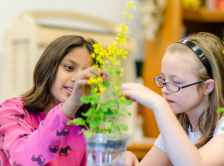
Emily Calandrelli, The Space Gal, Took Fast Plants Experiments & Seed Into Orbit!On November 22, 2024, science communicator, author, and engineer Emily Calandrelli became an astronaut and successfully conducted two Fast Plants experiments in space aboard the NS-28 Blue Origin mission. This mission is a milestone in space science and education. Be sure to follow #fastplantsinspace with Emily, @thespacegal, to learn how your students can participate, too! In this and several other NASA and Space Force Projects, Fast Plants have once again reached for the stars—this time with the help of Emily Calandrelli, a dynamic engineer, author, and champion of STEM education. Partnering with Space Force and the Wisconsin Fast Plants® Program, Calandrelli contributed to sending two experiments involving Fast Plants to space. One of these, launched aboard the NS-28 Blue Origin Mission, explores the fascinating world of plant growth in microgravity. This milestone is also a fresh chance for STEM educators to connect students with space-based research. The nutrient Fast Plants experiment, still active post-flight, offers a compelling way to bring space science... |

















